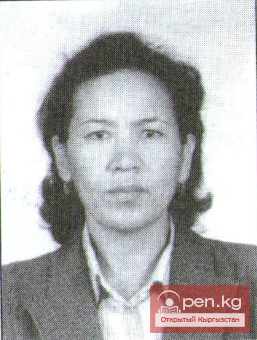
Umetov Jumabay (1933-1995) Applied artist. People's Artist of the Kyrgyz SSR. Laureate of the...

Kyrgyz Masters of the Easel In the 1970s, Murat Bekdzhanov established himself as a fine...

Until the 1960s, Ignatiev's work predominantly featured Kyrgyz themes, primarily related to...
API error: no response...

If A. Voronin early established himself as a realist artist with a distinctive creative face, then...

Paintings by Sabyrbek Akylbekov In the paintings of Sabyrbek Akylbekov, the color palette is...

Success was more easily achieved through traditional means of plein air painting, especially...

Kasyimov Toktogul Applied artist. Painter. Born on June 15, 1943, in the village of Kyzyl-Suu,...

Before the revolution, the Kyrgyz people knew visual arts only in its folk, applied form. The art...

Sabitjan Bakashev places great importance on the beauty of pictorial texture and the brightness of...

Satar Aitieva took his own path in stationary painting, having obtained a degree as a film set...

Academicism of Kyrgyz Painters Kulchoro Kerimbekov, Jakul Kozakhmetov, and Altymysh Usubaliev, who...

The creative program of Nurdamir Kongurbayev is clearly manifested in his studies. In terms of...

Years of hard work were devoted to the watercolors of R. Nudel. His watercolors "are mainly...

Belek Jumabaev, endowed with vivid imagination and sharp observation, was the first to paint...

The contradictory search for Sapara Torobekov. In his painting, two lines develop: tonal-plein...

Joоmart Kadraliev also resorts to the language of allegory, but his allegories have a more...

The monumentalist artist Vladimir Georgievich Butorin most vividly and originally expressed...

Kydyrmasheva Gulnara Koichubekovna Applied artist. Born on January 27, 1953, in the village of...

The creativity of Gapar Aitiev in the 1960s and 70s was exceptionally fruitful: it was the peak of...

Toktogonov Eshbolot Ajibayevich Applied artist. Honored Worker of Culture of the Kyrgyz Republic....

A remarkable phenomenon in Kyrgyz visual art was the creativity of Sabyrbek Akylbekov. His...

The restlessness of the creative interests of artists, sensitive to the most important aspects of...

Tashiev Jumagul Applied artist. Born on January 10, 1956, in the At-Bashinsky district. In 1981,...

Turkmenova Atyrkyl Applied artist. Born on September 28, 1958, in the village named after Sultan...

Osmonova Cholpon Abdrayevna Applied artist. Born on August 24, 1966, in the city of Frunze. In...

The working days and traditional way of life are the themes of Mukhtar Mukambetov's...

Tyan Leonid Nikolaevich Painter. Sculptor. Born on January 15, 1950, in the East Kazakhstan...

Nurova Mayramkan Toichuevna Applied artist. Born on September 15, 1958, in the village of Boru,...

Asanov Temirbek Imanalievich Applied artist. Born on October 15, 1953, in the city of Przhevalsk....

Mels Akynbekov is the closest to the creative program of B. Jumabaev. He turned to the memories of...

Pryt'kova Lyudmila Alexandrovna Art historian. Doctor of Cultural Studies. Corresponding...

Leonid Fedorovich Deimant primarily worked in the genre of thematic painting, often without any...

Ibraimova Orozbu Artist - applied artist. Painter. Born on April 10, 1957, in the village of...

New Trends in Herzen's Creativity While S. Bakashev represents the decorative direction of...

Dagai Marina Applied artist. Born on February 24, 1975, in the city of Zhanatas, Kazakh SSR. In...
Creative Inspiration: Venera Saadanbekova from the Tyup District Creates Unique Paintings. Venera...

Outstanding contemporary artist Semyon Afanasyevich Chuykov In the post-war period, as in previous...

The Versatility of Alexei Nikolaevich Kamensky. Alexei Nikolaevich Kamensky has developed into a...

Thematic Painting Aman Asrankulov works in the field of portrait and thematic composition. In such...

Paintings by Kubanychbek Amankozhoev As mentioned earlier, the first artist to somewhat depart...

Kaiypova Zhumabyuby Applied artist. Born on January 29, 1949, in the collective farm...

Ruppel Valery Fyodorovich Applied artist. Born on October 1, 1948, in the city of Korkino,...

The Independence of Artistic Thinking of Yevgeny Stepanovich Herdyuk. Yevgeny Stepanovich Herdyuk...

Lysenko Tatyana Alexandrovna Applied artist. Born on April 9, 1944, in the city of Jalal-Abad,...

Sooronbaev Sheraly Abdykassovich Applied artist. Born on June 13, 1974, in the village of Kadu,...

The singer of the mountain nature of Kyrgyzstan was the prematurely deceased artist-climber...

Zheenbekova Nurgul Erkinovna Applied artist. Born in October 1980 in the Nooken district of the...